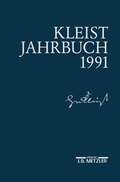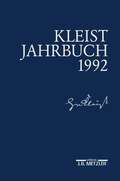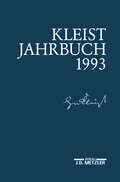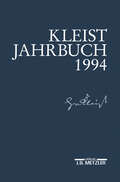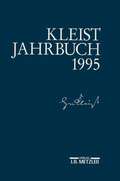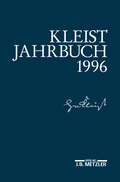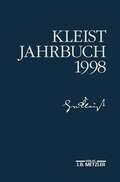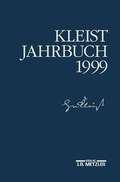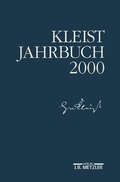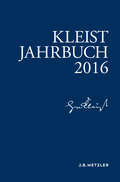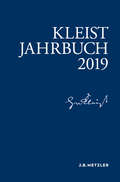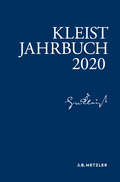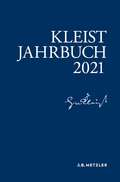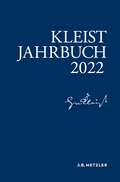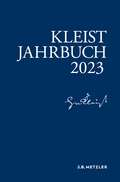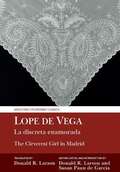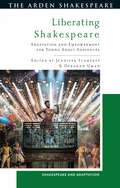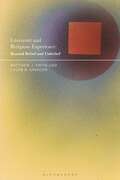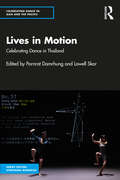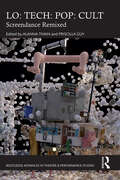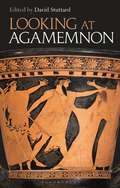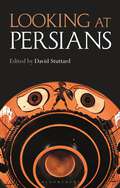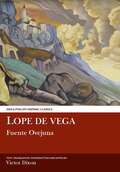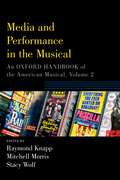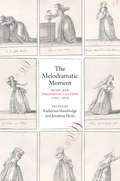- Table View
- List View
Kleist-Jahrbuch 1998 (Kleist-Jahrbuch)
Das Kleist-Jahrbuch 1998 erscheint erstmals unter neuer Herausgeberschaft: Günter Blamberger zeichnet für den Abhandlungsteil, Sabine Doering und Klaus Müller-Salget sind für den Rezensionsteil verantwortlich. Im Zentrum jedes Jahrgangs stehen wie bisher die Abhandlungen. Für 1998 sind u.a. Beiträge vorgesehen von Andreas Kablitz (Kleists Robert Guiscard" im Spiegel frühneuzeitlicher Konzepte des Tragischen), Bernhard Dotzler ("Federkrieg". Kleist und die Autorschaft des Produzenten), Hansjörg Bay ("Als die Schwarzen die Weißen ermordeten". Nachbeben einer Erschütterung des europäischen Diskurses in Kleists "Die Verlobung in St. Domingo"), Michel Chaouli (Devouring Metaphor: Disgust and Taste in Kleists "Penthesilea"), Bernhard Greiner (Wende zur Kunst und Engführung ihres Versprechens: Kleists Schaffen im Horizont der Kantischen Philosophie, am Beispiel des "Robert Guiscard"), Wolfgang Riedel (Kleists "moralische Erzählungen" und die Anthropologie um 1800), Helmut J. Schneider (Zu Kleists Anekdoten und dem anekdotischen Prinzip seiner poetischen Welt) und Ulf Abraham (Kanondebatten am Beispiel Kleists). Seit Jahrgang 1990 beim Verlag J.B. Metzler. Die Bände erscheinen in jährlicher Folge. Sie können zur Fortsetzung bezogen werden.
Kleist-Jahrbuch 1999 (Kleist-Jahrbuch)
Unter dem Titel »Kleists Duelle« behandelte die internationale Jahrestagung der Heinrich-von-Kleist-Gesellschaft im Juni 1998 in Hamburg vielfältige Aspekte von Kleists Streitkultur.
Kleist-Jahrbuch 2000 (Kleist-Jahrbuch)
Das diesjährige Kleist-Jahrbuch widmet sich schwerpunktmäßig dem Rahmenthema Kleist und die Weltliteratur", u.a. mit Beiträgen von Anthony Stephens (Melbourne), Wolfgang Pircher (Wien) zu "Vergeltung Recht und Politik bei Kleist", Christian Moser (Bonn) zu "Fallgeschichten bei Kleist und Montaigne", Claudia Liebrand Köln) zu Kleists Re-Lektüren von Boccaccios Novellen, Walburga Hülk-Althoff (Siegen) über Kleist und Flaubert sowie Ingo Breuer Köln) zur Tradition der Novelle. Des weiteren enthält der Band die Abteilung "Abhandlungen", u.a. mit einem Beitrag von Michael Wetzel (Kassel), sowie einen umfangreichen Rezensionsteil."
Kleist-Jahrbuch 2016
Das aktuelle Jahrbuch dokumentiert die Verleihung des Kleist-Preises 2015 mit den Reden der Preisträgerin Monika Rinck, der Vertrauensperson der Jury Heinrich Detering und des Präsidenten der Heinrich-von-Kleist-Gesellschaft Günter Blamberger. Darüber hinaus enthält das Jahrbuch Beiträge zu Kleists Werken und Rezensionen wissenschaftlicher Neuerscheinungen zu Kleist.
Kleist-Jahrbuch 2019 (Kleist-Jahrbuch)
Das Kleist-Jahrbuch 2019 dokumentiert die Verleihung des Kleist-Preises 2018 mit den Reden des Preisträgers Christoph Ransmayr, der Vertrauensperson der Jury László Földényi und des Präsidenten der Heinrich-von-Kleist-Gesellschaft Günter Blamberger. Den Schwerpunkt bilden die von Anne Fleig betreuten Beiträge der internationalen Jahrestagung der Heinrich-von-Kleist-Gesellschaft (in Kooperation mit der Deutschen Schillergesellschaft) ›Kleist und Schiller - Auftritt der Moderne‹ (u.a. von Peter-André Alt, Claudia Benthien, Christian Moser und Dorothea von Mücke) und die von Matthias N. Lorenz und Thomas Nehrlich geleitete Tagung ›Kleists Anekdoten – Zur Größe der Kleinen Formen‹ im Kleist-Museum, Frankfurt (Oder). Rezensionen und Miszellen beschließen den Band.
Kleist-Jahrbuch 2020 (Kleist-Jahrbuch)
Das Kleist-Jahrbuch 2020 dokumentiert die Verleihung des Kleist-Preises 2019 mit den Reden der Preisträgerin Ilma Rakusa, der Vertrauensperson der Jury Yoko Tawada und des Präsidenten der Heinrich-von-Kleist-Gesellschaft Günter Blamberger. Abhandlungen zu Kleists Werken, Miszellen zum Umfeld Kleists, Nachrufe auf Hans Joachim Kreutzer und Alexander Weigel sowie Rezensionen wissenschaftlicher Neuerscheinungen zu Kleist beschließen den Band.
Kleist-Jahrbuch 2021 (Kleist-Jahrbuch)
Das Kleist-Jahrbuch 2021 enthält neben Beiträgen zur ›Politik des Rechts im Werk Heinrich von Kleists‹ von Bernd Fischer, Antonia Eder, David Pan, Bernhard Greiner, Johannes F. Lehmann, Tim Mehigan und Christian Moser weitere Abhandlungen von Rüdiger Görner, Andreas Moser, Patrick Fortmann und Tobias Krüger. Rezensionen wissenschaftlicher Neuerscheinungen beschließen den Band.
Kleist-Jahrbuch 2022 (Kleist-Jahrbuch)
Das Kleist-Jahrbuch 2022 dokumentiert die Verleihung des Kleist-Preises 2020 im November 2021 mit den Reden des Preisträgers Clemens J. Setz, der Vertrauensperson der Jury Daniela Strigl und des Präsidenten der Heinrich-von-Kleist-Gesellschaft Günter Blamberger. Den Schwerpunkt bilden die von Andrea Allerkamp und Martin Roussel betreuten Beiträge der internationalen Jahrestagung der Heinrich-von-Kleist-Gesellschaft 2021 ›Um einen Kleist von außen bittend‹ (u.a. von László F. Földényi, Rüdiger Görner, Andrea Pagni, Paul Michael Lützeler und Carlotta von Maltzan). Abhandlungen zu Kleists Werken und Rezensionen wissenschaftlicher Neuerscheinungen zu Kleist sowie zu seinen historischen und systematischen Kontexten beschließen den Band.
Kleist-Jahrbuch 2023 (Kleist-Jahrbuch)
Das Kleist-Jahrbuch 2023 dokumentiert die Verleihung des Kleist-Preises 2022 im November 2022 mit den Reden der Preisträgerin Esther Kinsky, der Vertrauensperson der Jury Paul Ingendaay und der Präsidentin der Heinrich-von-Kleist-Gesellschaft Anne Fleig. Den Schwerpunkt bilden die von Andrea Bartl und Thomas Wortmann betreuten Beiträge einer Mannheimer Tagung zu ›Kleist in den Medien der Gegenwart‹ sowie Abhandlungen und Miszellen zu Kleists Werken (u.a. von Urs Jenny und Günter Dunz-Wolff zur Entstehung der beiden Fassungen des ›Michael Kohlhaas‹). Rezensionen wissenschaftlicher Neuerscheinungen zu Kleist sowie seinen historischen und systematischen Kontexten beschließen den Band.
La discreta enamorada / The Cleverest Girl in Madrid: Lope de Vega (Aris & Phillips Hispanic Classics)
This book is a Spanish/English edition of Lope de Vega’s La discreta enamorada. The core of the book consists of two texts: a critical edition of Lope’s play in Spanish and Donald R. Larson’s English translation/adaptation of that work. Common to the two texts are explanatory notes focusing on historical, cultural, and literary references. The Spanish text is further clarified by elucidations of difficult words or passages. The texts are preceded by a substantial introduction (discussing conventions of comedy, the comedia de capa y espada and its variation known as the comedia urbana, the political, social, and economic contexts of early 17th-century Madrid) and are followed by a critical apparatus that lists important variants that may be found in previous editions of Lope’s play.
Liberating Shakespeare: Adaptation and Empowerment for Young Adult Audiences (Shakespeare and Adaptation)
The collective trauma of the COVID-19 pandemic. Digital shaming. Violence against women. Sexual bullying. Racial slurs and injustice. These are just some of the problems faced by today's young adults. Liberating Shakespeare explores how adaptations of Shakespeare's plays can be used to empower young audiences by addressing issues of oppression, trauma and resistance. Showcasing a wide variety of approaches to understanding, adapting and teaching Shakespeare, this collection examines the significant number of Shakespeare adaptations targeting adolescent audiences in the past 25 years. It examines a wide variety of creative works made for and by young people that harness the power of Shakespeare to address some of the most pressing questions in contemporary culture – exploring themes of violence, race relations and intersectionality. The contributors to this volume consider whether the representations of characters and situations in YA Shakespeare can function as empowering models for students and how these works might be employed within educational settings. This collection argues that YA Shakespeare represents the diverse concerns of today's youth and should be taken seriously as art that speaks to the complexities of a broken world, offering moments of hope for an uncertain future.
Literature and Religious Experience: Beyond Belief and Unbelief
This book challenges the status quo of studies in literature and religion by returning to “experience” as a bridge between theory and practice. Essays focus on keywords of religious experience and demonstrate their applications in drama, fiction, and poetry. Each chapter explores the broad significance of its keyword as a category of psychological and social behavior and tracks its unique articulation by individual authors, including Conrad, Beecher Stowe and Melville. Together, the chapters construct a critical foundation for studying literature not only from the perspectives of theology and historicism but from the ways that literary experience reflects, reinforces, and sometimes challenges religious experience.
Lives in Motion: Celebrating Dance in Thailand (Celebrating Dance in Asia and the Pacific)
Lives in Motion celebrates dance in Thailand, focusing on the diversity of Thailand’s dance cultures and their place in today’s world. Giving voice to eminent artists and scholars on the complex roles that Thailand is pursuing for artful movement at home and abroad, the book provides key perspectives on Thai dance traditions and practitioners. It explores the many forms and meanings in contemporary dance, changing local traditions in the country, the evolution of Thai dance on the global stage, and hybrid features of the Thai dance world. The book examines how hybridity has been integral to dance cultures in Thailand and discusses how they have actively adapted and negotiated their knowledge in relation to modernity and globalization. Developing new models, standards and sites for dance, movement and theater, dance in Thai has been advancing in innovative ways, whether it is to include fresh forms of skilled bodily movement or to expand in new arenas like tourism and online platforms. Similarly, old systems of training, which included artists’ homes, palaces, and temples, have been adapted into the new world of modern education, media, home schooling, and new community rituals. A pioneering contribution on Thai performing arts, this volume examines contemporary Thai dance cultures in the local, national, regional, and global contexts. It will be of great interest to scholars and researchers of dance and performance studies, cultural studies, Southeast Asia studies, and art.
LO: Screendance Remixed (ISSN)
This edited collection assembles international perspectives from artists, academics, and curators in the field to bring the insights of screendance theory and practice back into conversations with critical methods, at the intersections of popular culture, low-tech media practices, dance, and movement studies, and the minoritarian perspectives of feminism, queer theory, critical race studies and more.This book represents new vectors in screendance studies, featuring contributions by both artists and theoreticians, some of the most established voices in the field as well as the next generation of emerging scholars, artists, and curators. It builds on the foundational cartographies of screendance studies that attempted to sketch out what was particular to this practice. Sampling and reworking established forms of inquiry, artistic practice and spectatorial habits, and suspending and reorienting gestures into minoritarian forms, these conversations consider the affordances of screendance for reimaging the relations of bodies, technologies, and media today.This collection will be of great interest to students and scholars in dance studies, performance studies, cinema and media studies, feminist studies, and cultural studies.
Looking at Agamemnon
Agamemnon is the first of the three plays within the Oresteia trilogy and is considered to be one of Aeschylus' greatest works. This collection of 12 essays, written by prominent international academics, brings together a wide range of topics surrounding Agamemnon from its relationship with ancient myth and ritual to its modern reception. There is a diverse array of discussion on the salient themes of murder, choice and divine agency. Other essays also offer new approaches to understanding the notions of wealth and the natural world which imbue the play, as well as a study of the philosophical and moral questions of choice and revenge. Arguments are contextualized in terms of performance, history and society, discussing what the play meant to ancient audiences and how it is now received in the modern theatre. Intended for readers ranging from school students and undergraduates to teachers and those interested in drama (including practitioners), this volume includes a performer-friendly and accessible English translation by David Stuttard.
Looking at Persians
Aeschylus' Persians is unique in being the only extant Greek tragedy on an historical subject: Greece's victory in 480 BC over the great Persian King, Xerxes, eight years before the play was written and first performed in 472 BC. Looking at Persians examines how Aeschylus responded to such a turning point in Athenian history and how his audience may have reacted to his play. As well as considering the play's relationship with earlier lost tragedies and discussing its central themes, including war, nature and the value of human life, the volume considers how Persians may have been staged in fifth-century Athens and how it has been performed today. The twelve essays presented here are written by prominent international academics and offer insightful analyses of the play from the perspectives of performance, history and society. Intended for readers ranging from school students and undergraduates to teachers and those interested in drama (including practitioners), this volume also includes an accurate, accessible and performance-friendly English translation of Persians by David Stuttard.
Lope de Vega: Fuente Ovejuna (Aris & Phillips Hispanic Classics)
Fuente Ovejuna (C.1613) is the most famous and frequently performed play by the creator of Spanish theatre, Lope de Vega (1562-1635). Astonishingly for its period, it celebrates the murder in 1476 of a nobleman, the Grand Commander of the Military Order of Calatrava, by the peasants he had oppressed, and their subsequent solidarity under torture. Fuente Ovejuna , however, is less a history lesson or political tract than an optimistic moral fable. Spanish text with facing-page translation, introduction and notes.
Media and Performance in the Musical: An Oxford Handbook of the American Musical, Volume 2 (Oxford Handbooks)
For the past several years, the American musical has continued to thrive by reflecting and shaping cultural values and social norms, and even commenting on politics, whether directly and on a national scale (Hamilton) or somewhat more obliquely and on a more intimate scale (Fun Home). New stage musicals, such as Come from Away and The Band's Visit, open on Broadway every season, challenging conventions of form and content, and revivals offer audiences a different perspective on extant shows (Carousel; My Fair Lady). Television musicals broadcast live hearken back to 1950s television's affection for musical theatre and aim to attract new audiences through the accessibility of television. Film musicals, including Les Misérables and Into the Woods, capitalize on the medium's technical capabilities of perspective and point of view, as well as visual spectacle. Television has embraced the genre anew, and with unexpected gusto, not only devising musical episodes for countless dramatic and comedy series, but also generating musical series such as Galavant and Crazy Ex-Girlfriend. And animated musicals, such as Disney's Moana, hail child and adult audiences with their dual messages, vibrant visual vocabulary, and hummable music. The chapters gathered in this book, Volume II of the reissued Oxford Handbook, explore the American musical from the various media in which musicals have been created to the different components of a musical and the people who do the work to bring a musical to life.
The Melodramatic Moment: Music and Theatrical Culture, 1790–1820
We seem to see melodrama everywhere we look—from the soliloquies of devastation in a Dickens novel to the abject monstrosity of Frankenstein’s creation, and from Louise Brooks’s exaggerated acting in Pandora’s Box to the vicissitudes endlessly reshaping the life of a brooding Don Draper. This anthology proposes to address the sometimes bewilderingly broad understandings of melodrama by insisting on the historical specificity of its genesis on the stage in late-eighteenth-century Europe. Melodrama emerged during this time in the metropolitan centers of London, Paris, Vienna, and Berlin through stage adaptations of classical subjects and gothic novels, and they became famous for their use of passionate expression and spectacular scenery. Yet, as contributors to this volume emphasize, early melodramas also placed sound at center stage, through their distinctive—and often disconcerting—alternations between speech and music. This book draws out the melo of melodrama, showing the crucial dimensions of sound and music for a genre that permeates our dramatic, literary, and cinematic sensibilities today. A richly interdisciplinary anthology, The Melodramatic Moment will open up new dialogues between musicology and literary and theater studies.
